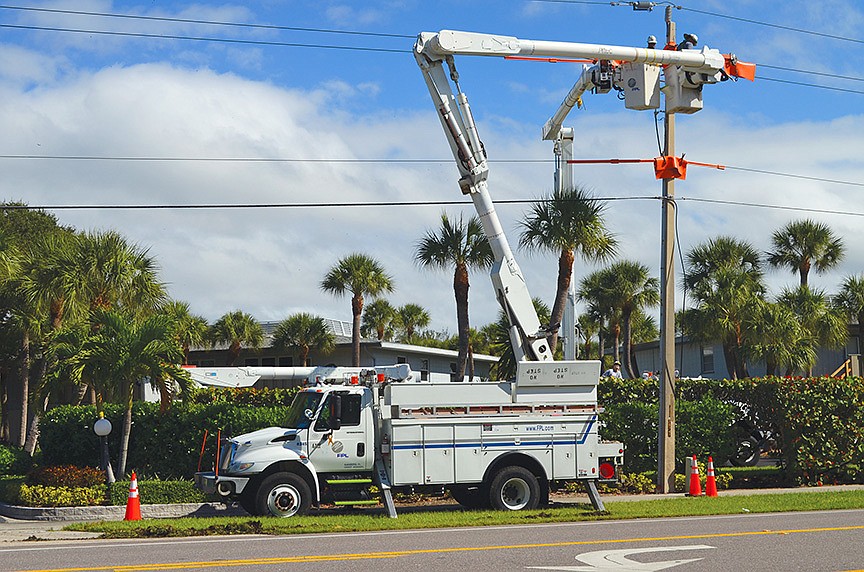- April 25, 2024
-
-
Loading

Loading

Give them credit. Longboat Key Mayor Jack Duncan and Town Manager David Bullock thought they had a strategy to save the town and taxpayers from a long-lasting, bitter divide between Longboat’s northern and southern halves.
But, alas, they were unable to persuade the town commissioners.
Nagged by complaints and protests mainly from residents of the Longbeach Village and the north end that converting the Key’s neighborhoods to underground utility lines was too costly, Duncan and Bullock unveiled Tuesday a creative idea to lessen the conversion: non-ad valorem assessment for all.
It really was creative — that is, if you’re in the Village camp and think it’s unfair and wrong that residents in neighborhoods with above-ground electrical wires should pay 82% of the cost, and those in neighborhoods with underground lines (e.g. mostly south Longboat) should pay only 18%.
Bullock proposed to the Town Commission Tuesday afternoon that the town fund anywhere from 20% to 50% of the $1.7 million annual debt service of the neighborhood underground project from the town’s non-ad valorem revenues (see lower box), reducing the annual assessments for everyone.
Great idea. Except that it falls in that Milton Friedman category of government spending: “What you give to one, you must take from another.”
Shifting up to, say, $878,160 a year from the general fund obviously would have meant Bullock would have had four choices to make up that new shortfall. Either:
At Tuesday’s Town Commission workshop, the town manager showed how increasing the property tax could increase property taxes on a property assessed at $750,000 from $147 to $226 a year.
At the same time, the average non-ad valorem assessment for neighborhood underground lines could look like this for a single-family home over 30 years:
For condominium owners, the average assessments would be:
Bullock also showed scenarios at increments of 20%, 30% and 40%.
At a glance, this strategy looked appealing. But surely you also can figure out pretty easily what the full consequences would have been:
Property owners who already have underground utility lines and property owners who have the town’s highest property-tax assessments would have paid a higher proportion of the increased property tax than most residents who have above-ground lines.
In short, those currently opposed to the cost of the underground utility conversion would receive a larger subsidy than previously proposed.
This would have had an ironic twist.
Up until Duncan and Bullock revealed their idea, opponents to the neighborhood underground conversion chafed over the minority of the Key’s property owners paying the overwhelming majority of the cost of the $23 million bond issue.
But had commissioners adopted the Duncan-Bullock idea, the vociferous minority would have succeeded in making commissioners feel sufficiently uncomfortable that it would have increased the minority’s subsidy at the expense of the majority.
But commissioners were not persuaded. They decided to stay with the 82%-18% non-ad valorem assessment plan.
It took courage. And Shannon Gault.
The Country Club Shores resident urged them to stand firm on the funding plan they already approved.
We were told that before the meeting, commissioners were ready to back the Bullock-Duncan plan.
But after Gault urged them to have backbone and railed at how the Bullock-Duncan plan would increase the subsidy and property taxes of residents who already have underground utility lines and who have the highest assessed values, the tide turned.
Commissioners recognized that if they changed course, voters no doubt would be confused. And when an electorate is confused, the tendency is to vote “no.”
A defeat of the neighborhood plan would also defeat the purpose of the Gulf of Mexico Drive underground approval in November. If voters don’t approve the neighborhood funding, Longboat still will have big, ugly poles at the entrance of every neighborhood fronting Gulf of Mexico Drive.
Tuesday’s session was another five-hour marathon on this one issue. But largely because of Gault, commissioners reached a 6-1 consensus to stick with the plan already in place. Commissioner Pat Zunz was the lone vote against keeping the existing funding plan.
Good for the commissioners.
As underground proponent Bob Gault told us Monday, “At this point, let’s just get it done.”
Longboat Key voters are smart. They will decide the issue on the merits for them and the town.